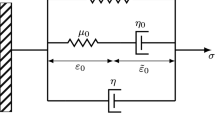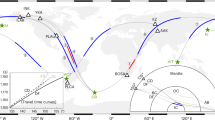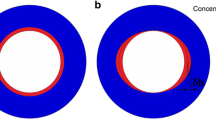Abstract
The crystalline solid inner core is the most distant and enigmatic part of our planet, and along with the Earth’s crust is the smallest one. The inner core was discovered in 1936 and to date there have been observed a number of its anomalous and puzzling features—low rigidity and viscosity (comparing to other solids), high seismic attenuation, strong anisotropy and differential rotation. The inner core is isolated from the upper solid Earth shells by the liquid outer core with low viscosity, and hence it can rotate, oscillate, precess, vibrate and move out along the spin axis. About 25 years ago studies of generation, evolution and sustainment of the Earth’s magnetic field launched active investigations of the crystalline core. Estimate of IC differential rotation velocity with respect to mantle is important for explaining a number of geodynamical patterns and effects—e.g. the observed global distribution of seismicity spatially coordinated with critical latitudes. One of the hypotheses associates the distribution with variation in the Earth’s rotation velocity. In this report we analyse information published thus far on differential rotation of the Earth’s inner core and acknowledge multiple controversies. The differential rotation velocity estimated by body waves is between 0° and 3° per year; the Earth’s normal mode data yield the velocities between –2.5° and –0.8° per year, whereas the most probable estimates are from –0.2° to 0.2° per year. The inner core stationary rotation envisaged by geodynamo simulations is unlikely; it is rather non-stationary—with accelerations/decelerations induced by the Earth’s mantle.
Access provided by Autonomous University of Puebla. Download conference paper PDF
Similar content being viewed by others
Keywords
1 Introduction
The inner core (IC) is the deepest and volumetrically smallest shell of the Earth. Since its discovery [1] there have been observed a number of its anomalous and puzzling features—low rigidity and viscosity (comparing to other solids), high seismic attenuation, strong anisotropy and differential rotation. IC is related to lots of problems—the ones of geophysics, geochemistry, magnetic field generation etc. It is affected by various external factors including changes in orbital and rotation parameters, tides, mantle gravity, outer core (OC) viscosity and electro-magnetic forces. Variation in thermal and chemical parameters may lead to IC internal strains resulting in differential rotation, convection in solid, deformations and anisotropy. IC is isolated from mantle by low viscosity liquid of the OC, so it can rotate, oscillate, precess and even move out from equilibrium [2,3,4,5]. Seismologists became interested in IC differential rotation due to geodynamo simulations [6], where its predicted strength and direction were determined by inner core boundary (ICB) conditions [7] and the balance between the gravitational and electromagnetic torques [8]. The IC rotation velocity was estimated as 1.6° per year, but later it turned out its precise value could be also important when explaining other geophysical processes that were not previously associated with the core. For example, distribution of seismicity around the critical latitudes—the region where the sign of deformations caused by rotation of the Earth inverts. This feature can be related to variation in rotation velocity of the Earth [9, 10]. Furthermore, Khain [11] suggests full accounting for the rotation factor in global geodynamics, not only for the purposes of explaining local configuration of crustal features like faults, cracks or lineaments.
Here we address studies of IC differential rotation to collate their outputs and constrain the range of possible IC rotation velocities with due consideration of mechanical models of such rotation.
2 IC Rotation by Seismic Body Waves
Seismological observations evidence faster propagation of seismic waves through the IC in quasi-meridional plane than in quasi-equatorial one by 3–4% [12]. It was also shown that the outer 2/3 of the IC feature cylindrical symmetry (anisotropy with transverse isotropy) [13]. Anisotropy of body wave propagation velocity (dependence of seismic velocity on the angle with the Earth’s rotation axis) is an important feature of core dynamics, that enables estimates of IC differential rotation (Fig. 1).
Left: example ray diagram for PKPdf and PKPbc ray paths for the case of quasi-meridional (or quasi-polar) propagation in the IC. Right: schematic representation of rotating IC. R—PKPdf ray vector in bottom refraction point, A0 … A1—consecutive directions of fast anisotropy axis in eastward rotating IC, ξ—angle between PKPdf ray and fast anisotropy axis
Song and Richards [3] estimated it as 1.1° per year on the base of dependence of differential travel time residuals ddt = (tbc – tdf)mea – (tbc – tdf)ref on calendar time. Specifically there were used PKPdf and PKPbc waveforms recorded after events at South Sandwich Islands (SSI) by the Alaskan station of COL 151° away (Fig. 2). They assumed the fast IC anisotropy axis was tilted with respect to the Earth’s spin axis, hence, if IC rotates, the angle (ξ) between PKPdf ray and the anisotropy axis should be dependent on time. It was found the dependence of ddt on calendar time makes 0.3 s each 30 years or 0.01 s per year. Using this value and the relation [14]:
the IC rotation velocity can be estimated between 0.4° and 1.8° per year (considering uncertainty)—here Rx, Ry and A0x, A0y, respectively, the directional cosines of vectors R (PKPdf ray direction in the bottom refraction point) and A0 (initial direction of fast anisotropy axis), k—regression slope of the experimental data, α—rotation velocity.
This estimate initiated a lot of criticism [15,16,17,18] mostly based on lack of evidence that the fast anisotropy axis did not coincide with spin axis. Besides, the observed trend of 0.3 s can result from source location error capable of making more than 50 km—it was shown the epicentral distance reduction procedure in such dataset can yield the bias of about the same value of 0.3 s. It was also noted that magnitude of the analyzed events systematically decreased in time, which encouraged positive trend in measured residuals. Finally, seismic paths to the Alaskan station of COL involve the subduction zone with its significant azimuthal heterogeneity, and IC anisotropy is not necessarily homogeneous, which may also contribute into the observed trend (though the latter factor in a lesser degree since the analyzed PKPdf propagation paths were scanning a restricted IC volume for which the assumption of anisotropic homogeneity was rather valid than not).
The IC rotation velocity of about 3º per year was also derived from spherical harmonics expansion of PKPdf–PKPbc differential measurements of ISC [4]:
It should be noted, that the analyzed ISC data featured high scatter and high-frequency variation. Creager [19] used linear parametric model to account for lateral velocity gradient in the IC:
where Ti—origin time, ξ—azimuth, Δ—epicentral distance, α—IC differential rotation rate, γ—coefficient of the linear model. For the data from [3] his estimate made 0.2°–0.3° per year with uncertainty of 0.05°–0.31° per year. Similar approach was invoked by Collier and Helffrich [20] who analyzed British records of Tonga events and obtained 0.47°–0.77° per year over 10 years long time period. Authors of the last referenced paper also admitted possible oscillations of the IC with period of about 280 days, whereas the initial westward rotation changes for the eastward one.
Ovtchinnikov et al. [21] showed that the jump in differential travel time residuals of about 0.3 s in Antarctic records of Novaya Zemlya explosions carried out between 1976 and 1979 was due to localized IC heterogeneity that rotated at 0.4°–1.8° per year. Table 1 lists some other estimates for events at SSI and in Eastern Siberia recorded at Alaska (FYU, COLA, SCM), Chukchi Peninsula (ILT) and in Antarctica (NVL, SBA, DRV, SNA), respectively. According to Table 1, the coefficient k that characterizes the change rate of IC differential rotation takes both signs. It can be explained by different configuration of seismic paths with respect to anisotropy axis. Joint interpretation of these data yields the IC rotation rate estimate of about 0.05° per year [22], which is comparable with lower bound by Creager [19]. We note, that the obtained values of slope k support IC rotation in the same direction including estimates at the Chukchi station of ILT, and the Alaskan stations of COLA, FYU and SCM that reside on the opposite sides of the subduction zone located beneath them (Fig. 2).
To scrutinize IC rotation, studies after the year of 2000 frequently invoked earthquake doublets—the events from essentially the same location, with same mechanism and energy (magnitude). Use of records of such events enables discarding the influence of near-source heterogeneities, whereas the PKPbc waveforms are not influenced by IC heterogeneities and exhibit extremely high correlation. If PKPdf arrivals correlate much worse, the IC fabric may undergo changes during the lapse time between the doublets, so the dislocation (and rotation) rate can be estimated by comparison of the waveforms.
Early studies of doublets estimated IC differential rotation rate by differential PKPbc–PKPdf travel time measurements treated as a result of dislocation of a restricted IC volume with lateral velocity gradient in it [23, 24]. The latter of the last referenced papers yields the rotation velocity of 0.27°–0.35° per year, and the former 0 ± 1° per year.
Unfortunately, the above results are not backed by normal mode studies that show the IC is rotating either as not rigid body, or at an insignificant rate of 0.11° ± 0.13° per year (e.g. [25]). These data however can be reconciled by the idea from [26], where differential travel times after doublets observed at COL were interpreted on the base of Bayesian statistic approach. They infer the IC rotation rate is time dependent, exhibits accelerations and decelerations, and, specifically, after the year of 2007 we’d expect westward, not eastward rotation. On the other hand, their outputs still contradict to slow (about 0.05°–0.1° per year) eastward rotation of scatterers in the IC observed by Vidale and Earle [27].
Another study [28] that produces results similar to the ones by normal modes invokes linear models of differential travel time dependency on calendar time (T) and the spatial coordinate of longitude (λ): ddti = a + b(Ti – T0) and ddti = c + d(λi – λ0). Table 2 shows some results. They show that except for station DAWY, measurements at all Alaskan stations do not contradict to early estimates of IC rotation rate based on anisotropy. On the other hand, measurements at the African station of BCAO (BGCA) yield the opposite sign of IC differential rotation velocity, and, consequently, do not support rotation (at least as a rigid body).
3 Mechanical Models of IC Differential Rotation
Here we address only two papers in the first of which [8] IC differential rotation is examined considering the combined effects of gravitational and electromagnetic torques, and friction caused by movements of the IC in the viscous OC. The moment of electromagnetic forces was estimated to 1018–1020 N m, and of gravitational ones to 1019–1021 N m. The retarding torque of rotating IC in the viscous turbulent medium of the OC makes about 1015 N m. If gravitational torque dominates, IC oscillates with periods between 1 and 10 years; if electromagnetic torque dominates, IC rotates with imposed rotation rate of the nearby OC fluids. When electromagnetic torques are only marginally stronger than the gravitational torques, the IC slowly rotates prograde by 90° relative to the mantle, escaping a gravitational well in roughly 100 years, then falls into the next gravitational well, rotating through 90° in just 4 years. Finite IC viscosity is modeled using a relaxation time for the IC topography. With relaxation, the gravitational torque reduces but does not eliminate the anomalous IC rotation.
Another model [29] does not account for electromagnetic torque but focuses on retarding crust and mantle rotation due to the tidal torque of the Moon and the Sun. Mathematically the problem is reduced to the classical problem of a nonlinear oscillator exposed to a constant torque. It was shown the IC can rotate either at the same angular velocity as mantle, or at a larger velocity (i.e. the model does not support slower IC rotation with respect to mantle). Fitting model parameters to account for the observed variation in Earth’s rotation velocity between 1955 and 2003 yields the gravitational torque is to exceed the tidal one by a factor of 5.9. It was also shown that ellipsoidality of the gravitationally interacting bodies provides a periodic interchange of kinetic angular momentum between mantle and solid core that results in either acceleration or deceleration of the IC.
4 Conclusions
It is obvious the rate of IC differential rotation is a topic to debate. Short-period body waves mostly predict eastward rotation at the rate of not more than 3° per year. Normal modes limit the rotation velocity by values an order of magnitude as small, and in both directions (eastward and westward). Simple eastward stationary rotation of the IC predicted by geodynamo simulations hardly exists, so the process is rather non–stationary, with accelerations and decelerations possibly induced by interaction with the Earth’s mantle.
References
Lehmann, I.: P’. Periodical: Publications du Bureau Central Séismologique International Series: A 14(3), 87–115 (1936)
Avsyuk, Y.N.: Possible explanation for latitude variation. Doklady Akademii Nauk SSSR 254(4), 834–838 (1980) (in Russian)
Song, X.D., Richards, P.G.: Seismological evidence for differential rotation of the earth’s inner core. Nature 382(6588), 221–224 (1996)
Su, W.-J., Dziewonski, A.M., Jeanloz, R.: Planet within a planet: rotation of the inner core of the Earth. Science 274(5294), 1883–1887 (1996)
Avsyuk, Y., Adushkin, V.V., Ovchinnikov, V.M.: Multidsciplinary study of the mobility of the Earth’s inner core. Izvestia Phys. Solid Earth 37(8), 673–683 (2001)
Gubbins, D.: Rotation of the inner core. J. Geophys. Res. 86(12), 11695–11699 (1981)
Glatzmaier, G.A., Roberts, P.H.: A three-dimensional convective dynamo solution with rotating and finitely conducting inner core and mantle. Phys. Earth Planet. Inter. 91(1–3), 63–75 (1995)
Aurnou, J., Olson, P.: Control of inner core rotation by electromagnetic, gravitational and mechanical torques. Phys. Earth Planet. Inter. 117, 111–121 (2000)
Levin, B.V.: Role of movements of the Earth’s inner core in tectonic processes. In: Fundamental Problems in General Tectonics, pp. 444—460. Nauchnyi Mir, Moscow (2001) (in Russian)
Levin, B.V., Sasorova, A.V., Domansky, V.A.: Features of “critical latitudes”, variations of rotation and seismicity of the earth. In: Vestnik of the Far East Branch of the Russian Academy of Sciences, vol. 3, pp. 3–8 (2013) (in Russian)
Khain, V.E.: Constructing a truly global model of Earth’s dynamics: basic principles. Russ. Geol. Geophys. 51(6), 587–591 (2010)
Poupinet, G., Pillet, R., Souriau, A.: Possible heterogeneity in the Earth’s core deduced from PKIKP travel times. Nature 305, 204–206 (1983)
Morelli, A., Dziewonski, A., Woodhouse, J.: Anisotropy of the core inferred from PKIKP travel times. Geophys. Res. Lett. 13, 1545–1548 (1986)
Song, X.D., Li, A.Y.: Support for differential inner core super-rotation from earthquakes in Alaska recorded at South Pole station. J. Geophys. Res.: Solid Earth 105(1), 623–630 (2000)
Souriau, A., Roudil, P., Moynot, B.: Inner core differential rotation: facts and artefacts. Geophys. Res. Lett. 24, 2103–2106 (1997)
Souriau, A.: New seismological constraints on differential rotation of the inner core from Novaya Zemlya events recorded at DRV, Antarctica. Geophys. J. Int. 134(2), F1–F5 (1998)
Poupinet, G., Souriau, A., Coutant, O.: The existence of an inner core super-rotation questioned by teleseismic doublets. Phys. Earth Planet. Inter. 118, 77–88 (2000)
Souriau, A., Poupinet, G.: Inner core rotation: a critical appraisal. In: Geodynamics Series, vol. 31. AGU, Washington (2003)
Creager, K.C.: Inner core rotation rate from small-scale heterogeneity and time-varying travel times. Science 278(5341), 1284–1288 (1997)
Collier, J.D., Helffrich, G.: Estimate of inner core rotation rate from United Kingdom regional seismic network data and consequences for inner core dynamical behavior. Earth Planet. Sci. Lett. 193(3–4), 523–537 (2001)
Ovtchinnikov, V.M., Adushkin, V.V., An, V.A.: The relative rotational velocity of the Earth’s inner core. Doklady Earth Sci. 363(8), 1117—1119 (1998)
Ovtchinnikov, V.M., Kaazik, P.B.: Station travel time residuals in calendar time and differential rotation of the inner core. In: Dynamic Processes in Geospheres. Collected Works of IDG RAS, pp. 10—19, Moscow (2011) (in Russian)
Zhang, J., Song, X., Li, Y., Richards, P.C., Sun, X., Waldhauser, F.: Inner core differential motion confirmed by earthquake waveform doublets. Science 309(5739), 1357–1360 (2005)
Song, X.D., Poupinet, G.: Inner core rotation from event-pair analysis. Earth Planet. Sci. Lett. 261, 259–266 (2007)
Laske, G., Masters G.: The Earth’s free oscillations and differential rotation of the inner core. In: Earth’s Core: Dynamics, Structure, Rotation. Geodynamic Series, vol. 31, Washington (2003)
Tkalčić, H., Young, M., Bodin, T., Ngo, S., Sambridge, S.: The shuffling rotation of the Earth’s inner core revealed by earthquake doublets. Nat. Geosci. 6(6), 497–502 (2013)
Vidale, J., Earle, P.: Evidence for inner core rotation from possible changes with time in PKP coda. Geophys. Res. Lett. 32, L01309 (2005). https://doi.org/10.1029/2004GL021240
Makinen, A., Deuss, A.: Global seismic body-wave observations of temporal variations in the Earth’s inner core, and implications for its differential rotation. Geophys. J. Int. 187(1), 355–370 (2011)
Denisov, G., Novikov, V., Fedorov, A.: Gravitational interactions of the solid core and the Earth’s mantle and variations in the length of the day. Astron. Rep. 52(12), 1027–1034 (2008)
Acknowledgements
This study is conducted under IDG RAS research plan (AAAA-A19-119022090015-6) with partial support from RFBR grant 18-05-00619.
Author information
Authors and Affiliations
Corresponding author
Editor information
Editors and Affiliations
Rights and permissions
Copyright information
© 2019 Springer Nature Switzerland AG
About this paper
Cite this paper
Ovtchinnikov, V., Krasnoshchekov, D. (2019). Rotation Factor: Dynamics and Interaction of the Earth’s Core and Mantle. In: Kocharyan, G., Lyakhov, A. (eds) Trigger Effects in Geosystems. Springer Proceedings in Earth and Environmental Sciences. Springer, Cham. https://doi.org/10.1007/978-3-030-31970-0_16
Download citation
DOI: https://doi.org/10.1007/978-3-030-31970-0_16
Published:
Publisher Name: Springer, Cham
Print ISBN: 978-3-030-31969-4
Online ISBN: 978-3-030-31970-0
eBook Packages: Physics and AstronomyPhysics and Astronomy (R0)






